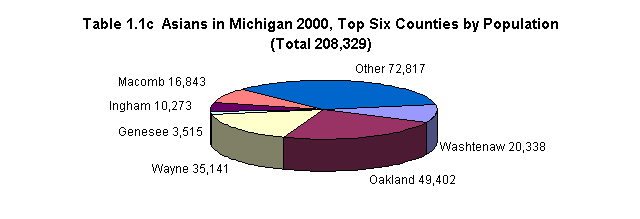
Sociodemographic
Characteristics &
Special
Health Issues of the U.S.Asian Population
After reading this chapter, you will be able to:
· Introduce the
sociodemographic characteristics of Asians in the U.S.
· Discuss the special
health problems of Asians in the U.S.
[back to top]
·
One of the fastest growing minority groups.
·
Disproportionate number of recent immigrants
·
Extreme diversity in language, culture, history and religion
·
Bipolar socioeconomic status, e.g., education and income
[back to top]
·
Asians have their special health concerns and problems, including mental and
reproductive health issues, and infectious, chronic, and sexually
transmitted diseases.
·
Frequently diagnosed cancers among Asians are lung, colorectal, breast, and
prostate
·
Cancer is the leading cause of death for
female Asian Americans.
·
The specific
health needs of Asians have often been overlooked due to stereotypes
of the “model minority” myth.
·
A lack of
information and understanding has resulted in a lack of resources, services, and
opportunities to meet the unique needs of the Asian community
[back to top]
_____________________________________________________________________________________
1.1
Sociodemographic
Characteristics of Asians in the U.S.
The United States is one of the world’s most
ethnically diverse nations, with the vast bulk of the population the descendants
of willing or unwilling immigrants.1
Asians, numbering more than 10 million in 2000, are a significant
minority in the U.S. and one of the fastest growing minority groups.
According to census data, Asians (including Pacific Islanders) increased
from 3.7 million in 1980 to more than 10.2 million in 2000, boosted largely by the continuing strength of
Asian immigration through the 1990s (Table 1.1a). It is estimated that the Asian population will double again
by the year 2025, when it is projected to reach 22 million.2

* The
2000 Census allowed multiple racial responses for the first time. Asian
Americans had a substantial multiracial population.
In combination with Asian alone and one or more other races, the Asian
American population was 11.9 million in 2000.
The growth in the
Asian population is largely due to recent immigrants and refugees.
Survey
data and immigration records indicate that most Asian Americans (about 60%) are
foreign born, and many settled in the U.S. after 1980.3
According
to the U.S. Bureau of the Census (1998), individuals in the Asian and Pacific
Islander population represent over 50 national and ethnic origins. They are
extremely heterogeneous in language, culture, history, religion, socioeconomic
status (e.g., education and income) and health indices.

*
Does not
include those who chose two or more races.
** Other Asian
alone, or two or more Asian categories.
Chinese constitute the largest Asian subgroup in the U.S., with a
population growth of 48%, from 1.6 million in 1990 to 2.4 million in 2000 (Table
1.1b). Like other Asians in the U.S.,
Chinese are relative newcomers with special sociodemographic characteristics and
health issues. Since 1965, when the U.S. Congress finally granted Asian
countries equal status in immigration law with countries in Europe, there has
been a rapid increase in the Chinese population throughout the U.S.
Among recent immigrants who came to the U.S. later in life, cultural
barriers, including language problems, are serious deterrents to adequate use of
health care[iv].
According to the 1990 Census, of the foreign born Chinese, 12.6% of the
families were below poverty level. In
terms of English speaking ability, 63% foreign born Chinese aged 5 years old and
older could not speak very well.
Asians in Michigan
There
has been a large increase in minority numbers, both locally and nationally,
since 1980.
In Michigan, the Asian population changed dramatically from 103,501 in 1990 to
208,329 in 2000, an increase of 101.3%. 65% of Michigan's Asian
population lives in the six counties of Oakland, Wayne, Washtenaw, Macomb,
Genesee, and Ingham. Oakland County has the largest Asian population. The
Census 2000 data shows that the greater Ann Arbor area is more racially and
ethnically diverse than ever before, and the fastest growing group is Asians.
See table 1.1c.

[back
to top]
1.2
Special Health Issues of Asians in the U.S.
·
Asians have some special health concerns and
problems, including mental and reproductive health issues and infectious,
chronic, and sexually transmitted diseases.
·
Cancer deaths dropped between 1990 and 1995 among
Americans but increased among Asian women.
Chinese have the highest rate of nasopharyngeal cancer in the U.S.
· Asian
women in the U.S. have a breast cancer risk 60% higher than women in Asia.
·
Cancer is the leading cause of death for female Asian Americans. In fact, Asian
American females are the first American population to experience cancer as the
leading cause of death. 5
·
Asian women tend to underutilize cancer
screening due
to cultural, linguistic, and economic barriers.
It had been reported, for example,
that 20.8 % of Asians and Pacific Islanders had no health insurance in
1999, compared to 15.5 % of the total U.S. population6.
These topics will be further explored in Chapter 3.
·
Breast cancer is the most frequently diagnosed cancer among Chinese,
Filipino, Japanese, and Korean and second most frequently diagnosed cancer for
Vietnamese (after cervical cancer). Colorectal
and lung cancer are also frequently diagnosed cancers in Asian women
· Among Asian
men, lung, prostate, and colorectal cancers are most frequently diagnosed.
· Asian and
Pacific Islander women are the only U.S. population group that experienced an
overall increase in cancer mortality for all cancers combined between 1990 and
1995.
· Asian's
specific health needs have been overlooked due to the misleading myth that they
are ‘a model and trouble free minority.’
Consequently, Asians remain one of the least understood ethnic groups. 7
·
There exists a serious lack of research and data
about Asian health issues, particularly about specific sub-groups within the
population. 8
[back to top]
 Back
to Chapter 1
Back
to Chapter 1




